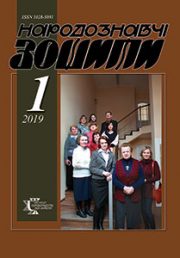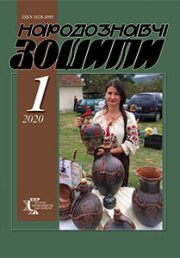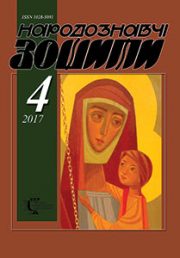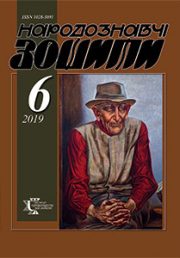The Ethnology Notebooks. 2020. № 1 (151), 36—48
UDK7.74.37.371.378
DOI https://doi.org/10.15407/nz2020.01.036
KATTRYNA ROMANIVNA SUSAK: TEACHER, LTADER, RESEARCHER AND MASTER OF EMBROIDERI, PUBLIK FIGURE
MOLYN Valentyna
ORCID ID: http://orcid.org/0000-0003-0815-6096
PhD in Art History,
assistant professor of the department of Fine Arts
and Academic Disciplines of Kosiv Institute of Applied
and Decorative Arts of Lviv National Academy of Arts,
2, Mitskevych St., 78600, Kosiv, Ukraine,
Contacts: e-mail: valentynamolyn@gmail.com
Abstract. Introduction. The article is dedicated to the anniversary of Kateryna Romanivna Susak, Honoured Worker of Education of Ukraine, initiator of the foundation and the first rector of Kosiv State Institute of Applied and Decorative Arts (today Kosiv Institute of Applied and Decorative Arts of Lviv National Academy of Arts), member of the National Union of Folk Art Masters of Ukraine.
Problem Statement. The rationale of the study is determined by the fact that over many years of pedagogical activity at the educational establishment K. Susak successively passed the stages of professional advancement, occupying positions of a teacher, deputy director, director and ultimately a rector. She led the work of an educational institution for more than eighteen years.
The author of the article keeps track of her research work, curricular practices and creative techniques, students’ graduate works supervision, as well as participation of the hero of the anniversary in various arts and cultural events.
Purpose. The goal of the article is to reveal personal long-lasting work and leadership of Kateryna Romanivna Susak as a teacher and head of the art educational institution in Kosiv. The attention is focused on her role in reformation and development of a growth strategy of the educational establishment in the context of reorganization of art institutions, state educational standards and creative staff training.
Methods. The principle of consistency, the method of historical reconstruction and the contextual one have been chosen as research methods. Photo-interviews are used at the stage of collecting and organizing primary information.
Results. Kateryna Romanivna Susak is engaged in the academic research work and scientific activity. She is known as the author of the published works and research articles, speaker at the international, all-Ukrainian and regional academic conferences, head and organizer of numerous events in the fields of art. She works creatively as a master of artistic embroidery; she is a civic-minded person and is actively involved in public life. A number of high government awards honours the educational work of K. Susak, they are medals, prizes, awards, titles of honour and orders.
Conclusion. The information given in the article can be used when writing a monograph publication about Kateryna Romanivna Susak.
Keywords: Kateryna Romanivna Susak, Kosiv Institute of Applied and Decorative Arts, teacher, leader, researcher, master, artistic embroidery.
Received 15.01.2020
REFERENCES
Susak, K. (2002). Formation of Higher Art Education in Kosiv. Mystetstvoznavstvo ’01, 1, 39—52 [in Ukrainian].
Susak, K. (2003). Artistic Embroidery of Verbovets Village, Kosiv Region. Mystetstvoznavstvo ’02, 2, 89—100 [in Ukrainian].
Susak, K. (2004). Autochnony in the Art of Embroidery. Journal of Lviv National Academy of Arts, 15, 154—164 [in Ukrainian].
Susak, K. (2005). Higher Art Education in Kosivshchyna: Historical and Pedagogical Aspects. Works of the Shevchenko Scientific Society (Vol. 1, pp. 91—103) [in Ukrainian].
Susak, K. (2007). To the History of the Establishment and Formation of Kosiv Art School (on its 125th anniversary). Journal of Lviv National Academy of Arts. Special (Issue ІІІ, pp. 22—49) [in Ukrainian].
Nykorak, O. (2012). Accomplishments of Kateryna Susak. Journal of Lviv National Academy of Arts, 23, 252—261 [in Ukrainian].
Nykorak, O. (2010). With Love to Art and Pedagogical Work. Works of the Shevchenko Scientific Society (Vol. 3, pp. 479—486) [in Ukrainian].
Molyn, V. (2014). Kateryna Susak: Creative Potential of a Teacher and Guiding Figure. Erdel’s Readings: International Research-to-practice Conference Information Package (Uzhhorod, 13—14 May 2014) (Pp. 181—186). Uzhhorod [in Ukrainian]
Molyn, V. (2019). Curator of Kosiv Art School. Obrazotvorche Mystetstvo, 3, 124—125 [in Ukrainian].
Kateryna Romanivna Susak: Bibliographical Reference. (2019). Коsiv [in Ukrainian].
Exhibition of Creative Works of Teachers and Students of V. Kasiian College of Applied and Decorative Arts: Catalogue. (1996). Lviv [in Ukrainian].
Marychevskyi, M. (2001). The Institute in Kosiv. Obrazotvorche Mystetstvo, 2, 51 [in Ukrainian].
Women of Ukraine 2006: Calendar Reference (2006). Kyiv [in Ukrainian].
Susak, K. (2001). Emmanuil Petrovych Mysko, the Academician, and Kosiv Art School. Journal of Lviv National Academy of Arts, 12, 302 [in Ukrainian].
Susak, K. (2012). Susak Anatolii Kalytko, the Painter and Teacher. Journal of Lviv National Academy of Arts, 23, 246—251 [in Ukrainian].
Susak, K. (2003). Paraska Shkribliak-Korol, the Lizhnyk-making Craftswoman. Obrazotvorche Mystetstvo, 4, 48—49 [in Ukrainian].
Susak, K. (2011). Dariia Hnatkivska, the Heroine of the Liberation Struggle for Independence of Ukraine. Hutsuls and Hutsulshchyna, 1, 52—59 [in Ukrainian].
Susak, K., & Stefiuk, N. (2006). Ukrainian Folk Embroidery (techniques, methodology, methods): textbook. Кyiv: Naukovyi Svit [in Ukrainian].
Nykorak. O. (Ed.). (2010). Hutsul Embroidery from the Collection of Y. Kobrynskyi National Museum of Folk Art of Hutsulshchyna and Pokuttia: monograph. Кyiv: Rodovid [in Ukrainian].
Losiuk, P., & Hryhoruk, A. (Eds.). (2012). Love You, Hutsulshchyna: study guide. Kosiv: Pysanyi Kamin [in Ukrainian].
Molyn, V. (2019). Altruistic Work for the Development of Kosiv Art School. Hutsulskyi Krai, 16, 5 [in Ukrainian].
Hryhoruk, A. (2019). At the Peak of Fruitful Life. Hutsulskyi Krai, 16, 5 [in Ukrainian].







